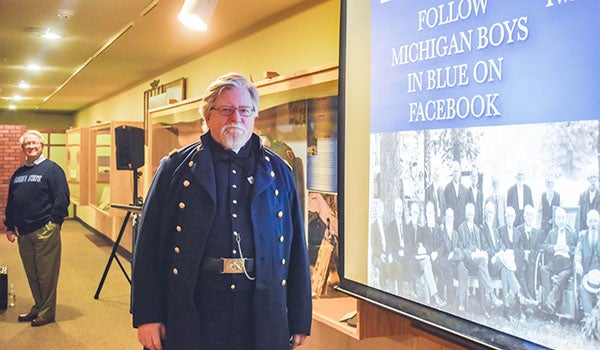Dowagiac Area History Museum kicks off lecture series with presentation on the Civil War
Published 8:43 am Friday, March 6, 2020
DOWAGIAC — At the Dowagiac Area History Museum Wednesday, visitors discovered Dowagiac’s roots in the Civil War.
John Urschel, the author of several books on Civil War regiments and soldiers, delivered a lecture at the Dowagiac Area History Museum titled “Dowagiac in the Civil War.” Urschel, who has a bachelor’s degree in history and a master’s degree in public history from Wright State University in Fairborn, Ohio, previously worked as a records manager and archivist for the city of South Bend and St. Joseph County, Indiana and as an information manager for the city of Kalamazoo.
He also worked as a contract archivist for the Buchanan District Library in 2011, which kicked off his journey of researching Civil War veterans in the area.
Urschel is now the author of “Michigan Boys in Blue,” a series of sourcebooks describing contributions to the Civil War effort from localities in Michigan. The sourcebooks include local soldiers with service histories, regimental summaries, photos, burials and other information.
More than 1,600 Cass County men served in the union forces during the civil war.
During his presentation, Urschel discussed the 19th Michigan Infantry, the 6th Michigan Infantry, 1st Michigan Calvary, and the 42nd Illinois Infantry. After introducing each Infantry, Urschel put the local soldiers on a screen so visitors could locate possible ancestors.
Urschel told a story of 6th Infantry’s battle in Baton Rouge, Louisiana.
“On Aug. 5, 1862, they were in these really nice barracks,” Urschel said. “They had written up all kinds of graffiti on these barracks.”
The 6th Infantry was told to move out of the barracks and go camp in the woods, even though they had no tents. Vermonters were moving into the barracks, and they had tents that were still being used in the barracks.
“All the officers of the 6th had a fit and a little hissy and were arrested and sent to New Orleans,” Urschel said. “All the officers of the 6th were in New Orleans when the Battle of Baton Rouge happened. So, the Infantry had no officers, and yet they defended a battery. They did very well.”
After a battle at Port Hudson in Louisiana, the 6th Infantry became the 6th Michigan Heavy Artillery, an unofficial title created by Union General Nathaniel Banks.
Urschel said when the war first started, when soldiers died, they were buried where they fell. It was not until three or four years later and after the Battle of Gettysburg that soldiers were buried in national cemeteries.
“Every battlefield that you visit, there are graves that you don’t see,” he said.
In the 1st Michigan Calvary, there were 62 Dowagiac soldiers all in company M. One audience member found an ancestor on the list but has not been able to find out if the ancestor came home alive.
Urschel also discussed the 42nd Illinois Infantry, which had 44 Dowagiac soldiers in company E.
“When the first call for soldiers went out, each state had a quota,” Urschel said. “Michigan’s quota was 3,000 men. That meant the first, second and third Michigan infantries went. All these guys were clamoring to go out to war.”
Urschel said they found a way to enter the war by going to Chicago. During his research, he found many soldiers from Michigan who went to other states to enlist.
Recently, Urschel’s research has focused on tracking down the records of 1,300 Michigan soldiers who were prisoners of war in Andersonville, Indiana.
“A lot of the guys I’ve found that were prisoners at Andersonville come back and die of cancer,” Urschel said. “There are 100 outliers on the chart, and cancer is a result of what they went through. They all had rheumatism and diarrhea. They had to eat the corn, along with the cobb.”
Urschel said the Michigan soldiers who were prisoners at Andersonville still lived as long as soldiers who never went to Andersonville.







